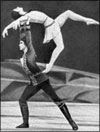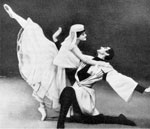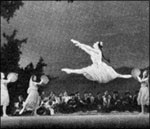|
BALLETS
“GAYANE”
 The
history of this score traces back to the ballet “Happiness”
composed in 1939… The
history of this score traces back to the ballet “Happiness”
composed in 1939…
“Setting to the creation of my first ballet score
I knew quite nothing about the specific character of
the ballet as a musical genre. While working, I managed
to seize and realize its characteristic peculiarities
rather quickly. The circumstance that ‘the element
of dance lives in Khachaturian’s music’
(Myaskovsky), must have helped me to a certain extent…”
This is the author’s own confession.
In a friendly talk with the composer, Anastas Mikoyan,
a prominent political figure of that time, asked him
to create a ballet by the upcoming “10 Days of
Armenian Art” (it became one of the first in the
Armenian musical theatre and the first of the national
ballets performed at the prewar “Days of Art”).
This idea completely corresponded to the composer’s
own creative aspirations. The theme of the ballet was
born in the same time, during the talk with Mikoyan
. He advised Khachaturian to meet the well-known Armenian
producer Gevorg Hovhanesyan who had recently written
a ballet libretto “Happiness” about the
life and labor of Soviet frontier-guards and collective
farmers.
 The
composer was working to a tight deadline. Khachaturian
spent the spring and summer of 1939 in Armenia gathering
folklore material – just here he began the deepest
study of the native melodies. Writer Maxim Gorky had
advised that to him. In spite of the dancing character
of the music, Khachaturian set the task “to symphonize”
the ballet. He wanted the folk songs and dancing melodies
to be integrated into the ballet and become inseparable
from the whole music of the ballet. Thus, Khachaturian
rather quickly realized and formulated the basic concepts
of his musical-choreographic esthetics. The
composer was working to a tight deadline. Khachaturian
spent the spring and summer of 1939 in Armenia gathering
folklore material – just here he began the deepest
study of the native melodies. Writer Maxim Gorky had
advised that to him. In spite of the dancing character
of the music, Khachaturian set the task “to symphonize”
the ballet. He wanted the folk songs and dancing melodies
to be integrated into the ballet and become inseparable
from the whole music of the ballet. Thus, Khachaturian
rather quickly realized and formulated the basic concepts
of his musical-choreographic esthetics.
The work on “Happiness” score lasted only
half a year. The well-known conductor Constantin Sarajev,
a disciple of Arthur Nickish, went through the rehearsals.
Everything was done to ensure that the Moscow tour of
the Armenian Spendiarov Theatre of Opera and Ballet
within the frameworks of the “Armenian Days of
Art” should be a success. C. Sarajev gathered
a gorgeous orchestra. In October 24, 1939, the ballet
“Happiness” was performed in Moscow in Bolshoi
Theatre and merely fascinated the audience. Many participants
received governmental rewards, and enthusiastic reports
did not stop appearing in newspapers.
However, it did not prevent the composer from a realistic
estimation of weak sides of his work. The libretto also
was not perfect.. And, nevertheless, “Happiness”
proved a good “springboard” for the real
blossom of Khachaturian’s ballet mastery. Soon,
the administration of the Leningrad Kirov Theatre of
Opera and Ballet offered to stage “Happiness”
with a new libretto…
As a result, the entire score “Happiness”,
according to the figurative expression of its author,
was “disintegrated” by himself…
Everything was completed with the creation of the ballet
“Gayane”, but it happened only during the
World War II. Here are the composer’s reminiscences
about that period:
 “I
lived in Perm on the 5th floor of the hotel ‘Central’.
Whenever I recall that time I think how many difficulties
people had to face then. The front needed weapon, bread,
tobacco… Both the front and the rear, however,
had another need art as well – food for reflection.
Hence we, artistes and musicians, realized that and
did the utmost of our power. About 700 pages of ‘Gayane’
score were written for half and year in a cold small
living-room, where stood a piano, a stool, a tabl,e
and a bed. It is more precious to me that ‘Gayane’
is the only ballet on the Soviet theme that did not
disappeared from the stage for a quarter of the century…” “I
lived in Perm on the 5th floor of the hotel ‘Central’.
Whenever I recall that time I think how many difficulties
people had to face then. The front needed weapon, bread,
tobacco… Both the front and the rear, however,
had another need art as well – food for reflection.
Hence we, artistes and musicians, realized that and
did the utmost of our power. About 700 pages of ‘Gayane’
score were written for half and year in a cold small
living-room, where stood a piano, a stool, a tabl,e
and a bed. It is more precious to me that ‘Gayane’
is the only ballet on the Soviet theme that did not
disappeared from the stage for a quarter of the century…”
The “Sabre Dance”, according to the author’s
words, was born by chance. The rehearsals began after
the completion of the ‘Gayane’ score. The
theatre director called Khachaturian and said that a
dance should be added to the last act. The composer
set to the work unwillingly: he considered the ballet
completed. Yet he began to think over that suggestion.
“The dance was to be rapid, warlike, - recalls
Khachaturian. – My hands took the accord impatiently
and I started playing it as an ostinato, repeated figure.
I needed a sudden shift and took an introductory tone
from the high level. Something struck me, - yes, I should
repeat it in the other key! The principle is set! Now
I need a contrast…. In the 3rd part of the ballet
a have a melodious theme, a lyrical dance. I linked
the warlike basis to this theme, - it is performed by
saxophone, - and then got back to the beginning, but
in the new character. I set to work at 3 PM and got
everything completed by 2 AM at night. At 11 next morning
the dance sounded at the rehearsal. It was staged by
the evening and its general rehearsal took place the
next day… ”
 The
ballet “Gayane” on K.Derzhavin’s libretto
was staged by N.Anisimova in December 1942, when the
grandiose battle was taking place by the city of Stalingrad.
The performance took place in Molotov, where Leningrad
Kirov Theatre had been evacuated to. As wrote the reviewers,
P.Feldt surpassed himself conducting the ballet at the
premiere. “Feldt gladdened us especially with
that inspired ardor which he as a talented ballet conductor
sometimes lacked,” – noted composer Dmitry
Kobalevsky. The
ballet “Gayane” on K.Derzhavin’s libretto
was staged by N.Anisimova in December 1942, when the
grandiose battle was taking place by the city of Stalingrad.
The performance took place in Molotov, where Leningrad
Kirov Theatre had been evacuated to. As wrote the reviewers,
P.Feldt surpassed himself conducting the ballet at the
premiere. “Feldt gladdened us especially with
that inspired ardor which he as a talented ballet conductor
sometimes lacked,” – noted composer Dmitry
Kobalevsky.
Whenever you watch “Gayane” in the theatre
or listen to this music at a concert or on records,
you somehow get an immediate impression; this impression
remains in your memory for a long time. A.Khachaturian’s
music is noted for its modal and harmonic, melodic and
orchestra generosity, which is connected with a broad
gamma of thoughts and feelings in the score –
a feature having few analogues in the history of music.
The three symphonic suites, arranged from the ballet
score by Khachaturian, promoted to make the music of
“Gayane” worldwide known.
 “
The evening of the premier of ‘Gayane’s’
First Suite is firmly engraved on my reminiscences,
- recalls singer N.Spiller. - Tthe Orchestra of the
All- -Union Radio was conducted by Golovanov that evening.
Neither before, nor after that day – it was in
October 3 , 1943 – had I happened to hear such
a burst of applause, such unconditional general success
of new work, as then, in the Column Hall of the Unions
House.” “
The evening of the premier of ‘Gayane’s’
First Suite is firmly engraved on my reminiscences,
- recalls singer N.Spiller. - Tthe Orchestra of the
All- -Union Radio was conducted by Golovanov that evening.
Neither before, nor after that day – it was in
October 3 , 1943 – had I happened to hear such
a burst of applause, such unconditional general success
of new work, as then, in the Column Hall of the Unions
House.”
Six years later, the great composer of the 20the century
Dmitry Shostakovich was glad to state the similar unanimous
success of the music of “Gayane” on the
other part of the globe – in New-York, at the
All-American Congress of Prominent Figures of Science
and Culture for Peace Protection, where “Gayane”
was performed by Stokovsky, a distinguished conductor.
Aram Khachaturian was awarded the Stalin Prize for the
ballet “Gayane”.
|